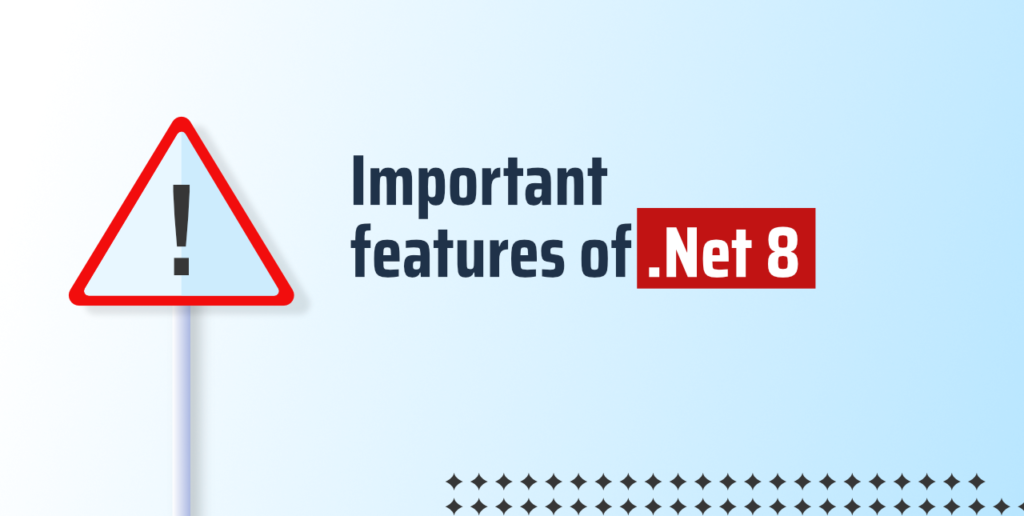The latest version of the .NET framework is .NET 8. Many new features of .NET 8 make it one of the most promising technologies ever.
.NET 8 is the newest open-source, cross-platform framework for building various applications, from web to mobile to desktop. Microsoft has refined its .NET framework to remain at the forefront of application development technology.
Combining the best features of .NET Core and the .NET Framework, .NET 8 is positioned as a powerhouse for developers looking to push the boundaries of what’s possible with their applications.
Microsoft launched this new version on November 14, 2023. If you’re excited about building reliable web applications or just curious about what Microsoft has packed into .NET 8, you’re at the right place.
In a dynamic business environment, scalability is crucial. IT services provide the flexibility to scale up or down your resources based on changing business needs. Cloud services, for instance, allow seamless expansion of storage and computational power

Serana Belluci
Product Designer
Important features of .Net 8
As a part of the long list of features of .NET 8, Microsoft has introduced enhanced performance, new language features like records and top-level programs, improved nullable reference types, and updated libraries.

• Enhanced Performance in .NET 8
Microsoft has released a new .NET version to increase Performance, prioritizing developing apps quickly, effectively, and seamlessly across platforms for developers. The new version of .NET optimized the runtime, consuming fewer resources and improving overall Performance. So, developers can launch apps faster through .NET optimization, enhancing end users’ overall experience.
.NET 8 has improved support for parallelism, allowing developers to write more scalable and efficient code. Profiling tools in .NET 8 give developers a thorough overview of application performance for easy troubleshooting.
Dynamic profile-guided optimization (PGO) in .NET 8 improves Performance by 15% on average, with 23% of tests showing improvements of 20% or higher.
• Long-term Support (LTS) Release
Unlike .Net 7, one of the key features of .Net 8 is the Long-term Support (LTS). In the earlier version, Microsoft provided updates and support only for three years. With .Net 8, Microsoft will keep supporting it, bringing stability and continuity.
Businesses looking to have enterprise applications and unwilling to invest in long-term maintenance charges will love these features. They can keep using them for longer periods, and they will have better reliability.
• Improved Support for IAsyncDisposable
As one of the features of .NET 8, IAsyncDisposable is an interface introduced to support asynchronous resource cleanup. It is similar to IDisposable, but it allows for asynchronous operations during the disposal of an object. This is particularly useful in dealing with asynchronous resources or cleanup tasks.
• Blazor Update
Blazor is a web framework for creating single-page applications where components can run on the server and client sides. This framework within the .NET ecosystem assists in developing interactive web applications with C# and .Net. Developers don’t need to use traditional JavaScript in development.
Though Blazor received many changes in the previous version, .Net 8 brought the most drastic one. With this update, the team can update content in the response stream for a better user experience. Now, it is capable of handling form posts more efficiently, so developers will feel the enhancement in web form development. Handling submissions will also become easy.
The Blazor update enabled standard URL fragments for navigating specific HTML elements. So, Blazor will navigate to the HTML elements automatically by noticing the fragment matching the element identifier. And there are more new features. Blazor now supports client-side routing. This means developers can easily navigate to specific sections of your webpage using standard URL fragments.
• AI and ML Support
As the world moves towards automation and much more with AL and ML, this new feature of .Net 8 is timed aptly. Now, developers will have simpler apps due to the use of AL and ML in complex algorithms and models.
Data analysis, predictive modeling, and automation are now feasible and efficient in the .Net ecosystem. Developers can integrate machine learning into applications for code analysis, debugging, and automating repetitive tasks.
The overall productivity of the development team will increase, and they can have more intelligent and data-driven applications in less time.
• System.Text.Json Serialization
Now, System.Text.Json will have better dependability and Performance in .Net 8. When the team uses this in Native AOT apps with ASP.NET Core, high Performance and customization will be easier. The update in System.Text.Json (JSON serialization library in . NET) will bring these changes.
1. Memory and ReadOnlyMemory<T> will have Base64 strings and other types of JSON arrays due to sterilization.
2. The JsonSerializerOptions class will have a TypeInfoResolverChain for assisting the TypeInfoResolver property. Now, developers can add chained components after the fact rather than specifying them all at once at the call site.
3. .Net 8 has support for serializing attributes from interface hierarchies
4. The ability to disable reflection-based serializers by default is beneficial in reduced and Native
5. Provision of new naming rules in JsonNamingPolicy for conversions to snake_case (with an underscore) and kebab-case (with a hyphen).
6. AOT programs for rooting reflection components not in use
7. Two different methods such as .JsonSerializerOptions.MakeReadOnly and JsonSerializerOptions.MakeReadOnly(Boolean), to manage when a JsonSerializerOptions instance freezes
• New C# Language Feature
As C# changes regularly, the need for change in the .NET ecosystem was felt. As a feature of .NET 8, Microsoft has tried to enhance the coding experience by making the version more efficient and expressive. The update has pattern matching, record types, and nullable reference types for developers to code in a maintainable and efficient manner.
• Better Tools and Integration
Similar to changes in the .NET ecosystem, the need for better tooling and integration choices increases in software development. By adopting this latest version, developers will discover a more efficient and productive working environment. Now, developers can focus more on designing top-quality applications.
.NET Core 8 brings enhanced tooling and allows for smooth integration with comprehensive development platforms such as Visual Studio. It has advanced debugging, profiling, and testing capabilities.
• Improvements in Compression
Now, it’s feasible to compress files from a folder through a stream without the necessity of storing them temporarily. The System.IO.Compression namespace has been expanded to include various APIs within the ZipFile class.
This advancement permits the direct handling of the compression outcome in memory. These APIs are invaluable when disk space is scarce. These APIs circumvent the requirement for temporary disk storage operations.
Conclusion
Microsoft’s .NET 8 is surely a leap forward for scalable, secure, robust, and performance-intensive application development. As developers, it’s time to explore these features in your projects and see how they can elevate the applications to new heights.
For developers working on anything from web and mobile applications to cloud services, desktop programs, or gaming software, .NET 8 offers essential resources and functionalities for success.
Its dedication to enhancing performance, fostering the ability to operate across various platforms, and promoting shared coding practices to streamline the development process are phenomenal.




